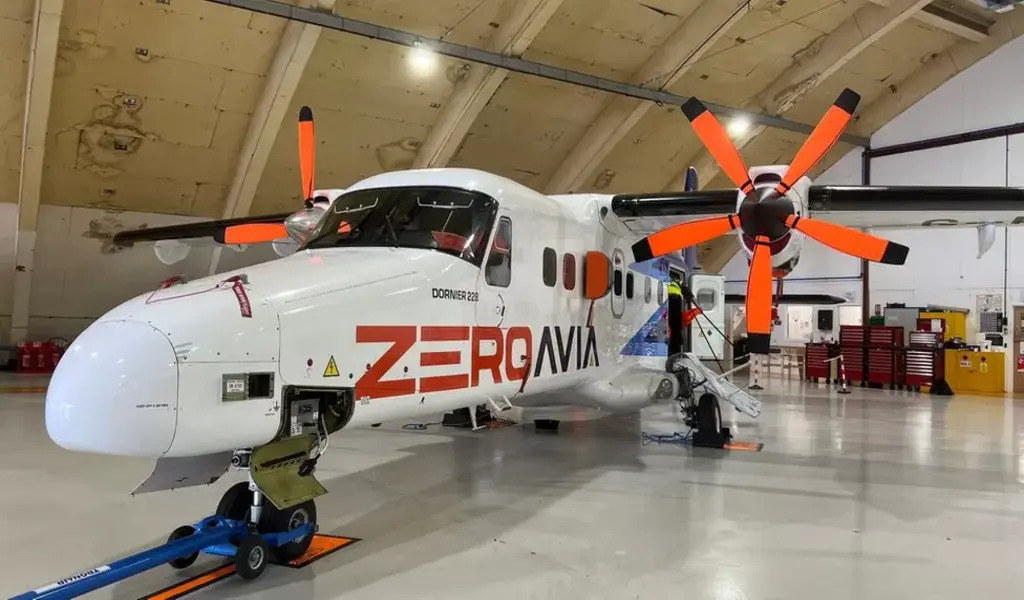News
Carbon-Emission-Free Aviation: An Ambitious ‘ZeroAvia’ Plan For Commercial Flights By 2025
(CTN NEWS) – By 2025, an aviation company is intending to operate commercial flights utilizing an electric engine that produces zero carbon emissions.
ZeroAvia has successfully conducted nine test flights at Cotswold Airport, located near Cirencester, using its hydrogen-electric engine.
The engine’s sole emission is water, making it environmentally friendly.
Sergey Kiselev, Vice-President of ZeroAvia, expressed that this engine would play a significant role in accomplishing “aviation decarbonization.”
While numerous aerospace companies are currently working on hydrogen-powered engines, their commercial viability is not anticipated until 2035.
However, a particular aviation company has managed to achieve this milestone earlier than expected. How did they accomplish it, and is it feasible to enable climate-friendly air travel sooner than previously anticipated?

ZeroAvia’s Innovative Approach: Retrofitting the Dornier 228 for Hydrogen-Electric Propulsion
The aerospace company based in Gloucestershire has expedited their progress by taking a different approach—they are not designing an entirely new aircraft.
ZeroAvia is focusing their efforts on the Dornier 228, a conventional 19-seater plane equipped with two propellers typically powered by kerosene.
To achieve their goal, one of the propellers has been replaced with an electric engine, and the necessary electricity is generated on-board using a hydrogen fuel cell.
During the testing phase, the other engine continues to be fueled by kerosene, serving as a backup in case of any issues.
Once the technology is proven successful, both engines will operate using electricity from the hydrogen fuel cell.
In terms of safety, only the new engine needs to pass the required tests, and ZeroAvia is collaborating with the Civil Aviation Authority to obtain certification.
Test pilot Jon Killerby has flown the aircraft and shared that once airborne, they have been able to rely solely on the hydrogen electric system, significantly reducing the use of the conventional engine.
“We can reduce the power output of the conventional engine,” he explained, “and rely entirely on the hydrogen electric system. It generates sufficient thrust to keep the aircraft flying level.”
The performance has been highly impressive, and the advancements have been remarkable indeed.
Green Hydrogen: A Promising Path towards Sustainable Aviation
Hydrogen fuel cells have been widely utilized in cars and trucks, making them a well-established technology.
These fuel cells operate through a chemical process known as “reverse hydrolysis,” where hydrogen combines with oxygen to generate heat, water vapor, and most importantly, electricity.
This means that the engine powered by these fuel cells produces no greenhouse gases.
However, the source of hydrogen is a crucial factor. Professor Tim Mays, who has been researching hydrogen for three decades at Bath University, leads the UK Hydrogen Research Hub, which recently received an £11 million grant to explore hydrogen’s potential in combating climate change.

Professor Mays explained, “Currently, hydrogen is primarily produced by treating natural gas with steam, which is an unsustainable method.”
However, it is also possible to produce hydrogen through electrolysis, a process that splits water into hydrogen and oxygen using renewable electricity.
This method yields “green hydrogen,” which is precisely what the aviation industry requires.
“It’s a highly viable option because we genuinely need to replace kerosene,” added Professor Mays.
In summary, hydrogen fuel cells are a well-known technology that can power engines without emitting greenhouse gases. The key lies in obtaining hydrogen from sustainable sources, such as through electrolysis using renewable electricity.
This approach, known as green hydrogen, holds great potential for addressing the aviation industry’s need to transition away from kerosene and reduce its carbon footprint.
ZeroAvia’s Hydrogen-Powered Aircraft: From Small to Large and Long-Range
The Dornier 228, equipped with a hydrogen engine, is not a large aircraft. It is designed to accommodate approximately 12 passengers.
According to Sergey Kiselev, the Chief Commercial Officer, this aircraft has a range of about 250 to 310 miles (400 to 500 km). With this capability, it could cover routes such as Bristol Airport to Newcastle or London to Paris.
ZeroAvia has further ambitions for the future. By 2027, they plan to develop a larger hydrogen-electric engine capable of powering bigger aircraft.
These aircraft would have the potential to carry approximately 50 passengers and achieve a range of around 620 miles (1,000 km).
In summary, the current Dornier 228 with a hydrogen engine is a smaller aircraft suitable for short-range flights, while ZeroAvia envisions larger hydrogen-electric engines to enable longer journeys with increased passenger capacity in the coming years.

Challenges in Implementing Hydrogen Aviation: Infrastructure and Efficiency
“Like any technology, there are challenges,” Professor Mays remarks with a smile, acknowledging the hurdles ahead.
The aviation industry faces the task of constructing an entirely new infrastructure to support hydrogen utilization.
This includes establishing hydrogen production centers, developing a network for fuel distribution to airports, and implementing proper storage facilities.
However, hydrogen differs significantly from conventional kerosene.
One of the challenges is the space required to store hydrogen. To manage it effectively, the gas needs to be compressed to 350 or 700 times atmospheric pressure. Even then, it occupies more space compared to kerosene.
If transportation as a liquid is desired, it must be chilled to an extremely low temperature of 253 degrees below zero.
Currently, airports and aerospace firms are actively investigating the most suitable locations for hydrogen production, devising efficient transportation methods, and exploring storage solutions.
Professor Mays summarizes the situation by stating, “While it is possible to fly using hydrogen as a fuel, the optimization and super efficiency are yet to be achieved, and the required infrastructure is still in development.”
In essence, the challenges of hydrogen implementation in aviation involve addressing storage and transportation constraints, as well as optimizing efficiency.
The airports and aerospace firms are diligently working towards finding viable solutions to overcome these obstacles.
ZeroAvia’s Accelerated Progress and the Aerospace Industry’s Interest
Despite its small hangar at Cotswold Airport, located far from the prominent research labs of Airbus, Rolls Royce, and Boeing, ZeroAvia has already secured orders for over 1,500 units of its initial engine.
One such customer is Air Cahana, a Californian airline dedicated to the mission of decarbonizing aviation. Another early adopter is Dale Vince, an environmental entrepreneur and founder of the renewable energy company Ecotricity.
Mr. Vince is launching an airline called “Ecojet,” which plans to utilize ZeroAvia engines for passenger flights, starting with routes from Edinburgh to Southampton.
He expressed, “The quest for sustainable air travel has troubled the environmental movement for decades.
The desire to explore our remarkable world is deeply ingrained in the human spirit, and flights free from CO2 emissions, powered by renewable energy, will finally allow us to do so without harming our planet.”
Prominent aerospace companies are closely observing the progress of the small start-up, ZeroAvia. Among them, Airbus stands out with its extensive research program named ZeroE, which also focuses on hydrogen technology.
Airbus is exploring various approaches, including hydrogen fuel cells to generate electricity for propeller propulsion, as well as using liquid hydrogen for direct combustion.
However, Airbus’s target for deploying hydrogen-powered planes into commercial service is set for 2035, a full decade later than the smaller engines developed by ZeroAvia.

According to Sergey Kiselev, their decision to modify an existing aircraft’s engine rather than designing an entirely new aircraft was driven by this disparity.
Kiselev explains, “This approach allows us to bypass the complexities associated with certifying an entire aircraft. We can concentrate solely on certifying the engine, enabling us to achieve commercial operations at a much faster pace.”
ZeroAvia has made a commitment to its ambitious timeline. Currently, the company faces two major challenges.
The first involves ensuring the safety, certification, and readiness of their engine for operational use by 2025, a goal they are well on their way to achieving.
The second challenge, which proves to be more difficult, revolves around ensuring a reliable supply of fresh hydrogen at the destination when the aircraft lands.
In summary, established aerospace giants like Airbus are closely monitoring the advancements of the small start-up, ZeroAvia.
ZeroAvia’s decision to modify existing aircraft engines instead of developing new ones has allowed them to accelerate their progress, with a target of commercial operations by 2025.
While they are making substantial strides in meeting their engine-related challenges, the task of establishing a consistent hydrogen supply at landing destinations remains a more demanding endeavor.
RELATED CTN NEWS:
Record-High Youth Unemployment In China Signals Struggling Post-Pandemic Recovery
South Korean President Blames Failure To Follow Disaster Response Protocols For Rising Death Toll

News
Google’s Search Dominance Is Unwinding, But Still Accounting 48% Search Revenue

Google is so closely associated with its key product that its name is a verb that signifies “search.” However, Google’s dominance in that sector is dwindling.
According to eMarketer, Google will lose control of the US search industry for the first time in decades next year.
Google will remain the dominant search player, accounting for 48% of American search advertising revenue. And, remarkably, Google is still increasing its sales in the field, despite being the dominating player in search since the early days of the George W. Bush administration. However, Amazon is growing at a quicker rate.
Google’s Search Dominance Is Unwinding
Amazon will hold over a quarter of US search ad dollars next year, rising to 27% by 2026, while Google will fall even more, according to eMarketer.
The Wall Street Journal was first to report on the forecast.
Lest you think you’ll have to switch to Bing or Yahoo, this isn’t the end of Google or anything really near.
Google is the fourth-most valued public firm in the world. Its market worth is $2.1 trillion, trailing just Apple, Microsoft, and the AI chip darling Nvidia. It also maintains its dominance in other industries, such as display advertisements, where it dominates alongside Facebook’s parent firm Meta, and video ads on YouTube.
To put those “other” firms in context, each is worth more than Delta Air Lines’ total market value. So, yeah, Google is not going anywhere.
Nonetheless, Google faces numerous dangers to its operations, particularly from antitrust regulators.
On Monday, a federal judge in San Francisco ruled that Google must open up its Google Play Store to competitors, dealing a significant blow to the firm in its long-running battle with Fortnite creator Epic Games. Google announced that it would appeal the verdict.
In August, a federal judge ruled that Google has an illegal monopoly on search. That verdict could lead to the dissolution of the company’s search operation. Another antitrust lawsuit filed last month accuses Google of abusing its dominance in the online advertising business.
Meanwhile, European regulators have compelled Google to follow tough new standards, which have resulted in multiple $1 billion-plus fines.

Pixa Bay
Google’s Search Dominance Is Unwinding
On top of that, the marketplace is becoming more difficult on its own.
TikTok, the fastest-growing social network, is expanding into the search market. And Amazon has accomplished something few other digital titans have done to date: it has established a habit.
When you want to buy anything, you usually go to Amazon, not Google. Amazon then buys adverts to push companies’ products to the top of your search results, increasing sales and earning Amazon a greater portion of the revenue. According to eMarketer, it is expected to generate $27.8 billion in search revenue in the United States next year, trailing only Google’s $62.9 billion total.
And then there’s AI, the technology that (supposedly) will change everything.
Why search in stilted language for “kendall jenner why bad bunny breakup” or “police moving violation driver rights no stop sign” when you can just ask OpenAI’s ChatGPT, “What’s going on with Kendall Jenner and Bad Bunny?” in “I need help fighting a moving violation involving a stop sign that wasn’t visible.” Google is working on exactly this technology with its Gemini product, but its success is far from guaranteed, especially with Apple collaborating with OpenAI and other businesses rapidly joining the market.
A Google spokeswoman referred to a blog post from last week in which the company unveiled ads in its AI overviews (the AI-generated text that appears at the top of search results). It’s Google’s way of expressing its ability to profit on a changing marketplace while retaining its business, even as its consumers steadily transition to ask-and-answer AI and away from search.

Google has long used a single catchphrase to defend itself against opponents who claim it is a monopoly abusing its power: competition is only a click away. Until recently, that seemed comically obtuse. Really? We are going to switch to Bing? Or Duck Duck Go? Give me a break.
But today, it feels more like reality.
Google is in no danger of disappearing. However, every highly dominating company faces some type of reckoning over time. GE, a Dow mainstay for more than a century, was broken up last year and is now a shell of its previous dominance. Sears declared bankruptcy in 2022 and is virtually out of business. US Steel, long the foundation of American manufacturing, is attempting to sell itself to a Japanese corporation.
SOURCE | CNN
News
2024 | Supreme Court Won’t Hear Appeal From Elon Musk’s X Platform Over Warrant In Trump Case

Washington — Trump Media, The Supreme Court announced Monday that it will not hear an appeal from social media platform X about a search warrant acquired by prosecutors in the election meddling case against former President Donald Trump.
The justices did not explain their rationale, and there were no recorded dissents.
The firm, which was known as Twitter before being purchased by billionaire Elon Musk, claims a nondisclosure order that prevented it from informing Trump about the warrant obtained by special counsel Jack Smith’s team violated its First Amendment rights.
The business also claims Trump should have had an opportunity to exercise executive privilege. If not reined in, the government may employ similar tactics to intercept additional privileged communications, their lawyers contended.
Supreme Court Won’t Hear Appeal From Elon Musk’s X Platform Over Warrant In Trump Case
Two neutral electronic privacy groups also joined in, urging the high court to hear the case on First Amendment grounds.
Prosecutors, however, claim that the corporation never shown that Trump utilized the account for official purposes, therefore executive privilege is not a problem. A lower court also determined that informing Trump could have compromised the current probe.

Trump utilized his Twitter account in the weeks preceding up to his supporters’ attack on the Capitol on January 6, 2021, to spread false assertions about the election, which prosecutors claim were intended to create doubt in the democratic process.
The indictment describes how Trump used his Twitter account to encourage his followers to travel to Washington on Jan. 6, pressuring Vice President Mike Pence to reject the certification, and falsely claiming that the Capitol crowd, which battered police officers and destroyed glass, was peaceful.
Supreme Court Won’t Hear Appeal From Elon Musk’s X Platform Over Warrant In Trump Case
That case is now moving forward following the Supreme Court’s verdict in July, which granted Trump full immunity from criminal prosecution as a former president.
The warrant arrived at Twitter amid quick changes implemented by Musk, who bought the company in 2022 and has since cut off most of its workforce, including those dedicated to combating disinformation and hate speech.
SOURCE | AP
News
The Supreme Court Turns Down Biden’s Government Appeal in a Texas Emergency Abortion Matter.

(VOR News) – A ruling that prohibits emergency abortions that contravene the Supreme Court law in the state of Texas, which has one of the most stringent abortion restrictions in the country, has been upheld by the Supreme Court of the United States. The United States Supreme Court upheld this decision.
The justices did not provide any specifics regarding the underlying reasons for their decision to uphold an order from a lower court that declared hospitals cannot be legally obligated to administer abortions if doing so would violate the law in the state of Texas.
Institutions are not required to perform abortions, as stipulated in the decree. The common populace did not investigate any opposing viewpoints. The decision was made just weeks before a presidential election that brought abortion to the forefront of the political agenda.
This decision follows the 2022 Supreme Court ruling that ended abortion nationwide.
In response to a request from the administration of Vice President Joe Biden to overturn the lower court’s decision, the justices expressed their disapproval.
The government contends that hospitals are obligated to perform abortions in compliance with federal legislation when the health or life of an expectant patient is in an exceedingly precarious condition.
This is the case in regions where the procedure is prohibited. The difficulty hospitals in Texas and other states are experiencing in determining whether or not routine care could be in violation of stringent state laws that prohibit abortion has resulted in an increase in the number of complaints concerning pregnant women who are experiencing medical distress being turned away from emergency rooms.
The administration cited the Supreme Court’s ruling in a case that bore a striking resemblance to the one that was presented to it in Idaho at the beginning of the year. The justices took a limited decision in that case to allow the continuation of emergency abortions without interruption while a lawsuit was still being heard.
In contrast, Texas has been a vocal proponent of the injunction’s continued enforcement. Texas has argued that its circumstances are distinct from those of Idaho, as the state does have an exemption for situations that pose a significant hazard to the health of an expectant patient.
According to the state, the discrepancy is the result of this exemption. The state of Idaho had a provision that safeguarded a woman’s life when the issue was first broached; however, it did not include protection for her health.
Certified medical practitioners are not obligated to wait until a woman’s life is in imminent peril before they are legally permitted to perform an abortion, as determined by the state supreme court.
The state of Texas highlighted this to the Supreme Court.
Nevertheless, medical professionals have criticized the Texas statute as being perilously ambiguous, and a medical board has declined to provide a list of all the disorders that are eligible for an exception. Furthermore, the statute has been criticized for its hazardous ambiguity.
For an extended period, termination of pregnancies has been a standard procedure in medical treatment for individuals who have been experiencing significant issues. It is implemented in this manner to prevent catastrophic outcomes, such as sepsis, organ failure, and other severe scenarios.
Nevertheless, medical professionals and hospitals in Texas and other states with strict abortion laws have noted that it is uncertain whether or not these terminations could be in violation of abortion prohibitions that include the possibility of a prison sentence. This is the case in regions where abortion prohibitions are exceedingly restrictive.
Following the Supreme Court’s decision to overturn Roe v. Wade, which resulted in restrictions on the rights of women to have abortions in several Republican-ruled states, the Texas case was revisited in 2022.
As per the orders that were disclosed by the administration of Vice President Joe Biden, hospitals are still required to provide abortions in cases that are classified as dire emergency.
As stipulated in a piece of health care legislation, the majority of hospitals are obligated to provide medical assistance to patients who are experiencing medical distress. This is in accordance with the law.
The state of Texas maintained that hospitals should not be obligated to provide abortions throughout the litigation, as doing so would violate the state’s constitutional prohibition on abortions. In its January judgment, the 5th United States Circuit Court of Appeals concurred with the state and acknowledged that the administration had exceeded its authority.
SOURCE: AP
SEE ALSO:
Could Last-Minute Surprises Derail Kamala Harris’ Campaign? “Nostradamus” Explains the US Poll.
-

 News4 years ago
News4 years agoLet’s Know About Ultra High Net Worth Individual
-
Entertainment2 years ago
Mabelle Prior: The Voice of Hope, Resilience, and Diversity Inspiring Generations
-
News11 years ago
Enviromental Groups Tell Mekong Leaders Lao Dam Evaluation Process Flawed
-

 Health4 years ago
Health4 years agoHow Much Ivermectin Should You Take?
-

 Tech3 years ago
Tech3 years agoTop Forex Brokers of 2023: Reviews and Analysis for Successful Trading
-

 Lifestyles3 years ago
Lifestyles3 years agoAries Soulmate Signs
-

 Entertainment3 years ago
Entertainment3 years agoWhat Should I Do If Disney Plus Keeps Logging Me Out of TV?
-

 Health3 years ago
Health3 years agoCan I Buy Ivermectin Without A Prescription in the USA?


